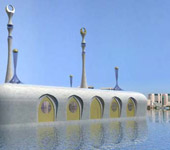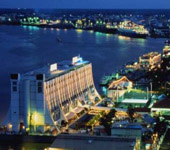Study on Floating Buildings
 Many spectacular plans do exist for floating buildings. Prof. Chang-Ho Moon of the Kunsan National University in Korea made it more concrete by studying 3 realized and 3 planned projects in terms of sustainability. Below you can download his study which appeared in the Journal of Navigation and Port Research, International Edition.
Many spectacular plans do exist for floating buildings. Prof. Chang-Ho Moon of the Kunsan National University in Korea made it more concrete by studying 3 realized and 3 planned projects in terms of sustainability. Below you can download his study which appeared in the Journal of Navigation and Port Research, International Edition.
Conclusion
Because of climate change and worldwide improvement of income levels, floating buildings on water have been emerging as a strong alternative for traditional buildings on land. The aim of this study is to suggest some reference materials of sustainability for new building projects on or at the waterside. The concept of sustainability and floating buildings is investigated, and 3 realized projects and 3 planned projects are reviewed in terms of sustainability. Sustainability of a floating building can be defined as an energy and ecologically conscious approach to a building for living/working space on a floatation system without a navigation tool.
floating building can be defined as an energy and ecologically conscious approach to a building for living/working space on a floatation system without a navigation tool.
Sustainable features of floating buildings from the sample projects can be summarized as follows: recycled and relocatable usage, adoption of various renewable energy techniques, installation of self-supporting plants, application of modular systems, and others like new material & open layout. Sustainable features need to be developed more and more in detail and applied to many types of floating buildings. With the development of pontoons, mooring and related floating technologies, the introduction of floating building will be expanded and will contribute enormously to enhance the sustainability of the earth in the future.
![]()
Download the full paper by clicking the PDF logo at the left.
Comment